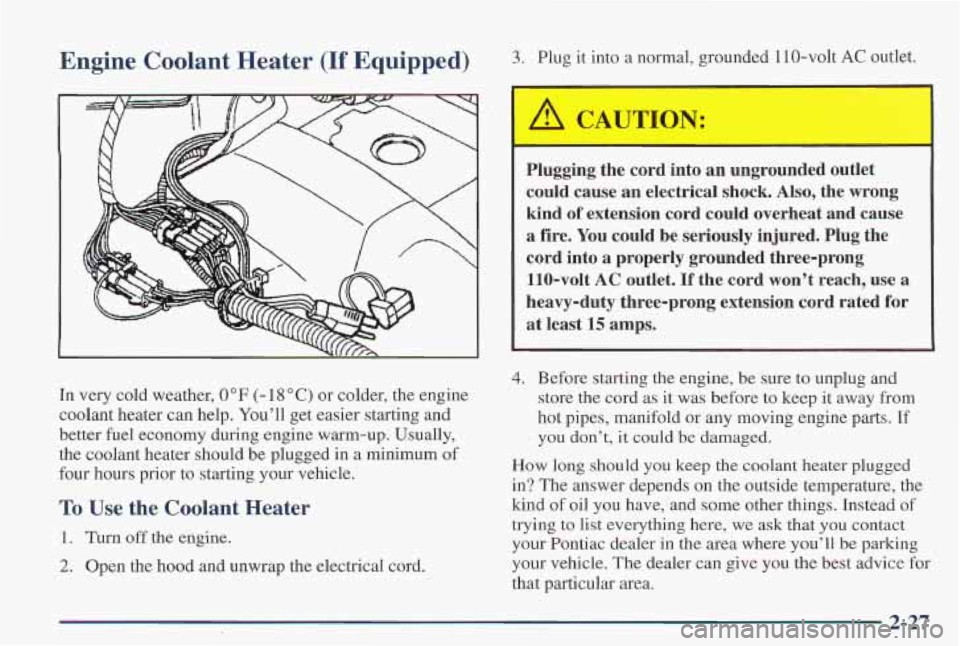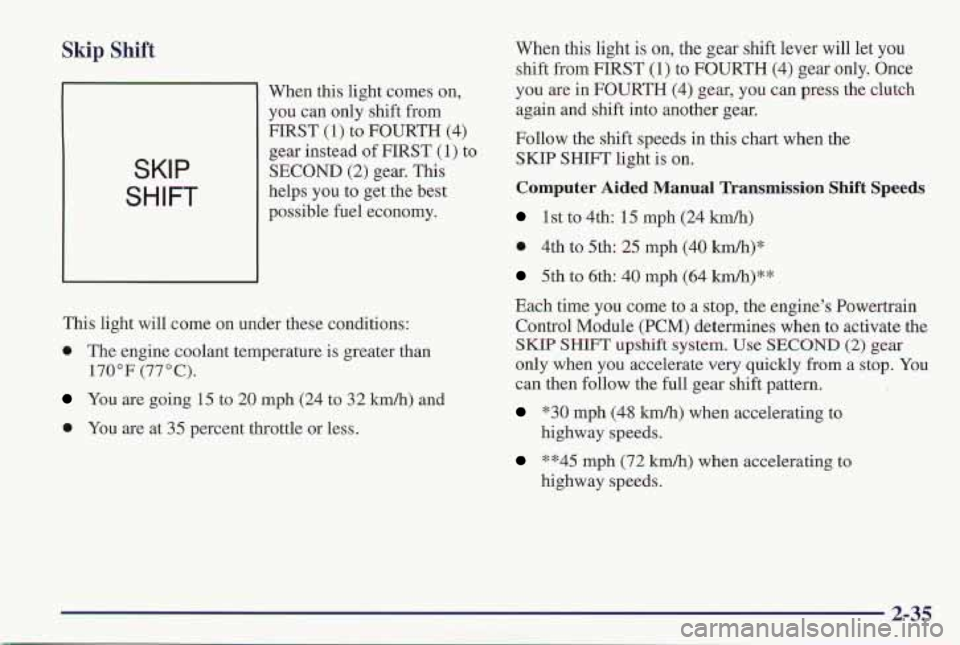coolant temperature PONTIAC FIREBIRD 1997 Owners Manual
[x] Cancel search | Manufacturer: PONTIAC, Model Year: 1997, Model line: FIREBIRD, Model: PONTIAC FIREBIRD 1997Pages: 410, PDF Size: 19.2 MB
Page 76 of 410

Engine Coolant Heater (If Equipped) 3. Plug it into a normal, grounded 110-volt AC outlet.
Plugging the cord into an ungrounded outlet
could cause
an electrical shock. Also, the wrong
kind
of extension cord could overheat and cause
a fire. You could be seriously injured. Plug the
cord into a properly grounded three-prong 110-volt
AC outlet. If the cord won't reach, use a
heavy-duty three-prong extension cord rated for
at least
15 amps.
In very cold weather, 0°F (- 18 "C) or colder, the engine
coolant heater can help. You'll get easier starting and
better fuel economy during engine warm-up. Usually,
the coolant heater should be plugged in
a minimum of
four hours prior to starting your vehicle.
To Use the Coolant Heater
1. Turn off the engine.
2. Open the hood and unwrap the electrical cord.
4. Before starting the engine, be sure to unplug and
store the cord as it was before to keep it away from
hot pipes, manifold or any moving engine parts. If
' you don't, it could be damaged.
How long should you keep the coolant heater plugged
in? The answer depends on the outside temperature, the
kind
of oil you have, and some other things. Instead of
trying to list everything here, we ask that you contact
your Pontiac dealer in the area where you'll be parking
your vehicle. The dealer can give you the best advice
for
that particular area.
2-27
Page 84 of 410

Skip Shift
SKIP
SHIFT
When this light comes on,
you can only shift from
gear instead of FIRST
(1) to
SECOND
(2) gear. This
helps you
to get the best
possible fuel economy.
FIRST
(1) tQ FOURTH '(4)
This light will come on under these conditions:
0 The engine coolant temperature is greater than
You are going 15 to 20 mph (24 to 32 km/h) and
0 You are at 35 percent throttle or less.
170°F (77°C).
When this light is on, the gear shift lever will let you
shift from FIRST (1) to FOURTH (4) gear only. Once
you are in FOURTH (4) gear,
you can press the clutch
again and shift into another gear.
Follow the shift speeds in this chart when the
SKIP SHIFT light is on.
Computer Aided Manual Transmission Shift Speeds
1st to 4th: 15 mph (24 kdh)
0 4th to 5th: 25 mph (40 km/h)*
5th to 6th: 40 mph (64 km/h)**
Each time you come to a stop, the engine's Powertrain
Control Module (PCM) determines when to activate the
SKIP SHIFT upshift system. Use SECOND (2) gear
only when you accelerate very quickly from a stop.
You
can then follow the full gear shift pattern.
*30 mph (48 kmh) when accelerating to
highway speeds.
**45 mph (72 km/h) when accelerating to
highway speeds.
2-35
Page 132 of 410

Engine Coolant Temperature Gage
This gage shows the engine
coolant temperature.
If the
gage pointer moves into the
red area, your engine is too
hot! It means that your
engine coolant has
overheated.
Low Coolant Light (VS Engine)
This warning light should
come on while you are
starting your engine.
If the
light doesn’t
come on, have
it repaired.
If you have been operating your vehicle under normal
driving conditions, you should pull off the road, stop
your vehicle and turn off the engine as soon as possible.
In “Problems
on the Road,” this manual shows what to
do. See “Engine Overheating” in the Index. Your
Firebird is equipped with
a LOW COOLANT
indicator which is designed to detect when the coolant
level drops below set limits. If the low coolant level
sensor (on the radiator) drops while the engine is
running,
the LOW COOLANT indicator will light and
remain lit until the ignition switch
is turned to the OFF
position. Check coolant level and add coolant as needed.
The LOW COOLANT light might stay on after filling
the radiator. Turn the ignition switch to the
OFF
position, then restart the engine to verify that the LOW
COOLANT light goes out. See “Engine Coolant” in
the Index.
2-83
Page 143 of 410

Heating
The heater works best if you keep your windows closed
while using it.
1. Turn the air control knob to HEATER.
2. Turn the fan control knob to the desired speed.
3. Turn the temperature control knob to a
During initial start-up only, if your vehicle is equipped
with
an optional engine coolant h'eater, you can use it in
cold weather (around +20°F/-8"C or lower) to improve
heater performance on start up, Because an engine
coolant heater
warms the engine coolant, your vehicle's
heating
system can more efficiently pro'vide heat for the
passenger area of your vehicle. See "Engine Coolant
Heater" in the Index.
comfortable
setting.
Bi-Level Heating
You may want to use bi-level heating on cool, but sunny
days. This setting directs cool air toward your body and
warmer air toward your feet. 1,
Turn the air control
knob to BI-LEVEL.
2. Turn the temperamre control knob to a
3. Turn the fan control knob to the desired speed.
comfortable
setting.
Ventilation
For mild outside temperatures when little heating or
cooling is needed, you can still direct outside air through
your vehicle.
I, Turn the air control knob to VENT.
2. Turn the temperature control knob to a
3. Turn the fan control knob to the desired speed.
co'mfortable setting.
Defogging and Defrosting
1. 'Turn
the air cantrol knob to DEFROST.
2. Turn the temperature control knob to the
3. Turn the fan control knob to the desired speed.
desired setting.
3-4
Page 219 of 410

Engine Overheating
You will find a coolant temperature gage on your
Pontiac's instrument panel. You may also find a LOW
COOLANT warning light on your Pontiac instrument
panel
(V8 Engine only).
If Steam Is Coming From Your Engine
Steam from an overheated engine can L,m you
badly, even if you just open the hood. Stay away
from the engine if you see or hear steam coming
from it. Just turn it off and get everyone away
from the vehicle until it cools down. Wait until
there is no sign
of steam or 'coolant before you
open the hood.
If you keep driving when your engine is
overheated, the liquids in it can catch fire. You or
others could be badly burned. Stop your engine if
it overheats, and get out of the vehicle until the
engine is cool.
-
NOTICE:
If your engine catches fire because yon keep
driving
with no coolant, your vehicle can be
badly damaged. The costly repairs
would not be
covered by your warranty.
5-14
Page 274 of 410

Rear Axle
When to Check and Change Lubricant
Refer to the Maintenance Schedule to determine how
often to check the lubricant and when to change it. See
“Scheduled Maintenance Services” in the Index.
How to Check Lubricant
If the level is below the bottom of the filler plug hole,
you’ll need to add some lubricant. Add enough lubricant
to raise the level to the bottom
of the filler plug hole,
What to Use
Standard Differential
Use Axle Lubricant (GM Part No. 12345977) or SAE
80W-90 GL-5 gear lubricant.
Limited-Slip Differential
To add lubricant when the level is low, use Axle
Lubricant (GM
Part No. 12345977). To completely refill
after draining, add 4 ounces
(1 18 ml) of Limited-Slip
Differential Lubricant Additive (GM Part
No. 1052358).
Then fill to the bottom of the filler plug hole with Axle
Lubricant
(GM Part No. 12345977).
Engine Coolant
The cooling s stem in your vehicle is filled with new
DEX-COOL 8 engine coolant. This coolant is designed
to remain in your vehicle for
5 years or 150,000 miles
(240
000 km) whichever occurs first, if you add only
DEX-COOL’ extended life coolant.
The following explains your cooling system and how
to add coolant when it is low. If you have a problem
with engine overheating or if you need to add coolant
to your radiator, see “Engine Overheating” in the Index.
A
50150 mixture’ of water and DEX-COOL@
coolant will:
Give freezing protection down to -34°F (-37°C).
Give boiling protection up to 265°F (129°C).
Protect against rust and corrosion.
e Help keep the proper engine temperature.
Let the warning lights and gages work as
they should.
Page 278 of 410

Radiator Pressure Cap (All Engines) Power Steering Fluid
I NOTICE:
Your radiator cap is an 18 psi (124 kPa)
pressure-type cap and must be tightly installed
to
prevent coolant loss and possible engine damage
from overheating.
Be sure the arrows on the cap
line up with the overflow tube on the radiator
filler neck.
When you replace your radiator pressure cap, an AC@
cap is recommended.
Thermostat
Engine coolant temperature is controlled by a thermostat
in the engine coolant system. The thermostat stops the
flow of coolant through the radiator until the coolant
reaches
a preset temperature.
When
you replace your thermostat, an AC@ thermostat
is recommended.
-
3800 Engine
When to Check Power Steering Fluid
It is not necessary to regularly check power steering
fluid unless you suspect there is a leak in the system or
you hear an unusual noise. A fluid loss in this system
could indicate a problem. Have the system inspected
and repaired.
6-33
Page 393 of 410

Electrical Equipment. Adding .......... 2.26.3.22. 6.68
Electrical System ............................... 6-68
Coolant Heater ............................... 2-27
Coolant Level Check .......................... 7-44
Coolant Temperature Gage
..................... 2-83
Identification ................................ 6-68
Overheating
................................. 5-14
RunningWhileParked
......................... 2-42
Specifications
................................ 6-73
Engine .................................. 6-10. 6-11
Coolant
..................................... 6-29
Exhaust
..................................... 2-41
FuseBlocks
................................. 6-70
OilLevelCheck
.............................. 7-44
StartingYour ................................ 2-25
Engineoil
.................................... 6-12
Adding
..................................... 6-14
Checking ................................... 6-13
Used ....................................... 6-18
Ethanol
........................................ 6-5
Additives ................................... 6-1'7
Pressure Gage
................................ 2-87
Whentochange
.............................. 6-17
Exhaust. Engine
................................ 2-4 1
Exit Lighting ............................. 2-18. 2-54
Exit Lightingmelayed Illumination ................. 2- 18
Express-Down Window .......................... 2-43
Fabric Cleaning ............................... 6-59
Fan Control. Climate Control System
................ 3-2
Feature Customization ........................... 2- 17
Exit Lighting ................................ 2-18
Last Door Closed Locking
...................... 2-19
Lockout Prevention
........................... 2-19
Remote Keyless
Entry Control Verification ......... 2-19
Theft-Deterrent Arming Method
................. 2-20
Theft-Deterrent Arming Verification
.............. 2-21
Fifth Gear. Manual Transmission
.............. 2-32. 2-34
Filling Your Tank
................................ 6-6
Filter. Engine Oil
............................... 6-17
Finishcare
.................................... 6-63
Finish Damage ................................. 6-65
First
Gear. Automatic Transmission ................ 2-31
First Gear. Manual Transmission .............. 2-32. 2-33
Flashers. Hazar'd Warning
......................... 5-2
Flat Tire. Changing ............................. 5-26
Fluids and Lubricants ............................ 7-50
Folding Rear Seatback ............................ 1-7
Foreign Countries. Fuel ........................... 6-5
Fourth Gear. Manual Transmission
............ 2-32. 2-34
Four-Way Manual Seat
........................... 1-3
Frontconsole .................................. 2-58
Delayed 11.lumination
Driver's
Door Alarm Delay/Shock Sensor Enable ... 2-22 2-18
..........................
Filter. Air ..................................... 6-20
FloorMats
.................................... 2-61
FogLamps
.................................... 2-53
French Language Manual 11
FrontTowing .................................. 5-10
Front Turn Signal Lamp Bulb Replacement .......... 6-43
.. ...........................